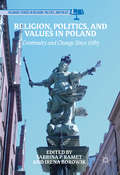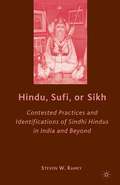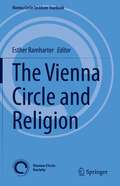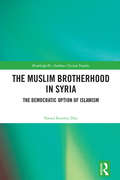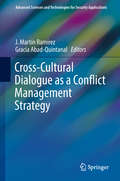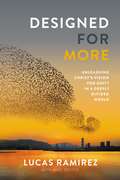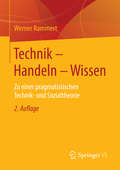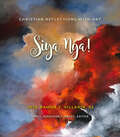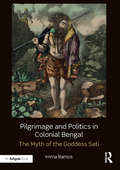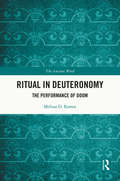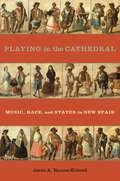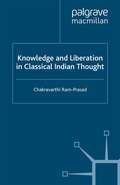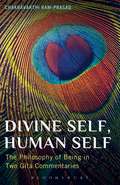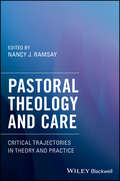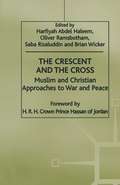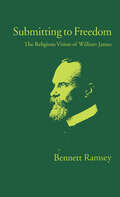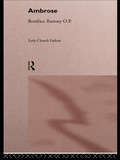- Table View
- List View
Religion, Politics, and Values in Poland: Continuity and Change Since 1989 (Palgrave Studies in Religion, Politics, and Policy)
by Sabrina P. Ramet Irena BorowikThis volume brings together leading scholars to examine how the Church has brought its values into the political sphere and, in the process, alienated some of the younger generation. Since the disintegration of the communist one-party state at the end of the 1980s, the Catholic Church has pushed its agenda to ban abortion, introduce religious instruction in the state schools, and protect Poland from secular influences emanating from the European Union. As one of the consequences, Polish society has become polarized along religious lines, with conservative forces such as Fr. Rydzyk’s Radio Maryja seeking to counter the influence of the European Union and liberals on the left trying to protect secular values. This volume casts a wide net in topics, with chapters on Pope John Paul II, Radio Maryja, religious education, the Church’s campaign against what it calls “genderism,” and the privatization of religious belief, among other topics.
Hindu, Sufi, or Sikh: Contested Practices and Identifications of Sindhi Hindus in India and Beyond
by S. RameyBy analyzing concrete examples of the creation of a heritage in the context of migration, this multi-sited ethnography considers the implications of representations of religions and diaspora for Sindhi Hindus and other similar communities.
The Vienna Circle and Religion (Vienna Circle Institute Yearbook #25)
by Esther RamharterThis book is the first systematic and historical account of the Vienna Circle that deals with the relation of logical empiricists with religion as well as theology. Given the standard image of the Vienna Circle as a strong anti-metaphysical group and non-religious philosophical and intellectual movement, this book draws a surprising conclusion, namely, that several members of the famous Moritz Schlick-Circle - e.g., the left wing with Rudolf Carnap, Otto Neurath, Philipp Frank, Edgar Zilsel, but also Schlick himself - dealt with the dualisms of faith/ belief and knowledge, religion and science despite, or because of their non-cognitivist commitment to the values of Enlightenment. One remarkable exception was the philosopher and Rabbi Joseph Schächter, who wrote explicitly on religion and philosophy after the linguistic turn. The book also covers another puzzling figure: the famous logician Kurt Gödel, who wrote on theology and the ontological proof of God in his so far unpublished notebooks. The book opens up new perspectives on the Vienna Circle with its internal philosophical and political pluralism and is of value to philosophers, historians and anybody who is interested in the relation between science and religion.
The Muslim Brotherhood in Syria: The Democratic Option of Islamism (Routledge/St. Andrews Syrian Studies Series)
by Naomí Ramírez DíazAnyone who follows world events has heard of the Muslim Brotherhood. Usually considered a fundamentalist religious organisation opposed to secular regimes, the so-called Arab Spring began to challenge this conception, and showed the MB’s commitment to democratic principles and elections, albeit with certain difficulties. Until now though, most analysis has focused on the Egyptian branch – the group that gave spiritual birth to the local branches in other countries – with very little having been studied about the Syrian Muslim Brotherhood, especially since the Hama massacre of 1982 and the formal disappearance of the group from Syria. This book provides a deep insight into the Syrian Muslim Brotherhood’s ideological evolution from its inception until present-day. Since Syria has unfortunately become the place where all forms of Islamism converge, understanding the SMB, their ideological evolution, and their potential role as moderating forces, is essential in order to debunk some clichés on the MB in general. Each chapter corresponds to a specific period in the SMB’s timeline, while the final chapter discusses how the endemic gerontocracy of the group calls for an urgent renovation of structures, and stresses the importance of younger generations in renovating the ideology of the SMB. Through the examination of original primary sources written by the SMB themselves, and relevant groups related to them, this book challenges the traditional categories applied to Islamist movements. It will therefore be a key resource for anyone studying Islamist movements, as well as for students and scholars of Middle East and North African Politics.
The Muslim Brotherhood in Syria: The Democratic Option of Islamism (Routledge/St. Andrews Syrian Studies Series)
by Naomí Ramírez DíazAnyone who follows world events has heard of the Muslim Brotherhood. Usually considered a fundamentalist religious organisation opposed to secular regimes, the so-called Arab Spring began to challenge this conception, and showed the MB’s commitment to democratic principles and elections, albeit with certain difficulties. Until now though, most analysis has focused on the Egyptian branch – the group that gave spiritual birth to the local branches in other countries – with very little having been studied about the Syrian Muslim Brotherhood, especially since the Hama massacre of 1982 and the formal disappearance of the group from Syria. This book provides a deep insight into the Syrian Muslim Brotherhood’s ideological evolution from its inception until present-day. Since Syria has unfortunately become the place where all forms of Islamism converge, understanding the SMB, their ideological evolution, and their potential role as moderating forces, is essential in order to debunk some clichés on the MB in general. Each chapter corresponds to a specific period in the SMB’s timeline, while the final chapter discusses how the endemic gerontocracy of the group calls for an urgent renovation of structures, and stresses the importance of younger generations in renovating the ideology of the SMB. Through the examination of original primary sources written by the SMB themselves, and relevant groups related to them, this book challenges the traditional categories applied to Islamist movements. It will therefore be a key resource for anyone studying Islamist movements, as well as for students and scholars of Middle East and North African Politics.
Cross-Cultural Dialogue as a Conflict Management Strategy (Advanced Sciences and Technologies for Security Applications)
by J. Martín Ramírez Gracia Abad-QuintanalThis book contributes to the current knowledge and research on conflict and cross-cultural dialogue, emphasizing how respect, tolerance and dialogue may be quite effective tools for bridging the diverse cultures and, consequently, for solving many of the conflicts of today’s world, characterized by a dynamic interchange of populations with very diverse cultural and ethnic backgrounds. For this purpose, we rely on reputed scholars from ten different countries, and from different cultures and fields of expertise, which allows for diverse contributions from a valuable interdisciplinary perspective. The first section of the book deals with the correlation between cultural differences and conflict, while also showing how such conflicts can be prevented and, should they arise, managed and solved. The second section addresses a different, more specific issue: how cultural expression means and tools for cultural communication may lead to conflict whereas they may help to avoid it as well. Finally, the third section analyzes how legal and justice systems deal with cross-cultural conflicts as well as with situations which may lead to cross-cultural conflicts, thus assessing to which extent such systems contribute to avoid and/or solve such kind of conflicts.
Designed for More: Unleashing Christ's Vision for Unity in a Deeply Divided World
by Lucas RamirezDesigned for More calls every Christian to consider how, through collective movement, they can bring about Christ's daring vision for unity in the Church to impact the world like never before.Our world is divided and fragmented.Even among followers of Christ, God's great story of reconciliation has been crippled because the messengers of that story are unreconciled.But God designed us for so much more. Thankfully, He has hidden incredible lessons in nature to help solve complex human problems.Designed for More draws groundbreaking implications for how to achieve unity and collective movement through new research on a jaw-dropping phenomenon of flocking starlings known as a murmuration. This marvel is one of nature's most spectacular sights: Imagine hundreds of thousands of birds in motion, caressing the sky like a brush on canvas. It is a beautiful madness that is completely ordered.Join authors Lucas Ramirez and Mike DeVito as they unveil the power of the murmuration principles in order to inspire unity in individuals and the Church as a whole.Birds first taught us to fly, and now they will teach us to unify!
Technik - Handeln - Wissen: Zu einer pragmatistischen Technik- und Sozialtheorie
by Werner RammertDas Anliegen dieses Buches ist es, die Lücke mangelnden Technikbezugs in der Sozial- und Gesellschaftstheorie zu füllen. Dazu werden mit Bezug auf Technik-, Medien-, Symbol- und Interaktionstheorien und speziell Ansätze der Praxistheorie von Dewey, Mead, Joas und Giddens konzeptuelle Vorschläge gemacht. An Beispielen wird gezeigt, wie mit diesen Konzepten der Technisierung, der soziotechnischen Konstellation und der hybriden Handlungsträgerschaft von Mensch, Maschine und Programm die Soziologie für die Analyse von Interaktivitäten mit Softwareagenten und Suchmaschinen, mit Robotern und autonomen Fahrzeugen fit gemacht werden kann. Wegen der Synthese techniksoziologischen Wissens kann es auch als Einführung in die Techniksoziologie für Fortgeschrittene und Interessierte anderer Fächer gelesen werden.
Siya Nga!: Christian Reflections with Art
by Jose Ramon T. Villarin, SJ“Siya Nga!” is a Filipino expression of wonder and, thus, of openness to possibilities. It is an expression of epiphany and eureka! This book offers the readers short reflections by Jose Ramon T. Villarin, SJ on fifty-two “familiar” terms in the Christian faith — terms that the author and editor deem significant in the life and living of those who share the Christian faith, either by religious affiliation or by spiritual aspiration.The reflections are elucidated by images of eighty artworks by fifty-four Filipino artists. The reflections seek to make these terms of faith —Incarnation, Trinity, Word, Freedom, even Christmas, for example — once again unfamiliar. In that way, and in Fr. Villarin’s own words, “the newness of God will never grow old, and the bigness of his love … will never grow small.” Reflection, etymologically speaking, means “bending back.” The bending back of perspectives allows readers to dwell once more on Christian wonder, openness, possibility, and epiphany.“Siya Nga!” was published in paper format by the De La Salle University Publishing House in 2019:ISBN (cloth): 978-971-555-680-4ISBN (paper): 978-971-555-679-8This ebook edition is a revised and enlarged edition from the original paper publication, and will be available in all the main ebook formats (Kindle [Mobi], ePUB, PDF) worldwide. The Kindle version will be on Amazon, and the other e-versions available for download purchase via other web vendors.
Siya Nga!: Christian Reflections with Art
by Jose Ramon T. Villarin, SJ“Siya Nga!” is a Filipino expression of wonder and, thus, of openness to possibilities. It is an expression of epiphany and eureka! This book offers the readers short reflections by Jose Ramon T. Villarin, SJ on fifty-two “familiar” terms in the Christian faith — terms that the author and editor deem significant in the life and living of those who share the Christian faith, either by religious affiliation or by spiritual aspiration.The reflections are elucidated by images of eighty artworks by fifty-four Filipino artists. The reflections seek to make these terms of faith —Incarnation, Trinity, Word, Freedom, even Christmas, for example — once again unfamiliar. In that way, and in Fr. Villarin’s own words, “the newness of God will never grow old, and the bigness of his love … will never grow small.” Reflection, etymologically speaking, means “bending back.” The bending back of perspectives allows readers to dwell once more on Christian wonder, openness, possibility, and epiphany.“Siya Nga!” was published in paper format by the De La Salle University Publishing House in 2019:ISBN (cloth): 978-971-555-680-4ISBN (paper): 978-971-555-679-8This ebook edition is a revised and enlarged edition from the original paper publication, and will be available in all the main ebook formats (Kindle [Mobi], ePUB, PDF) worldwide. The Kindle version will be on Amazon, and the other e-versions available for download purchase via other web vendors.
Pilgrimage and Politics in Colonial Bengal: The Myth of the Goddess Sati
by Imma RamosFrom the late nineteenth century onwards the concept of Mother India assumed political significance in colonial Bengal. Reacting against British rule, Bengali writers and artists gendered the nation in literature and visual culture in order to inspire patriotism amongst the indigenous population. This book will examine the process by which the Hindu goddess Sati rose to sudden prominence as a personification of the subcontinent and an icon of heroic self-sacrifice. According to a myth of cosmic dismemberment, Sati’s body parts were scattered across South Asia and enshrined as Shakti Pithas, or Seats of Power. These sacred sites were re-imagined as the fragmented body of the motherland in crisis that could provide the basis for an emergent territorial consciousness. The most potent sites were located in eastern India, Kalighat and Tarapith in Bengal, and Kamakhya in Assam. By examining Bengali and colonial responses to these temples and the ritual traditions associated with them, including Tantra and image worship, this book will provide the first comprehensive study of this ancient network of pilgrimage sites in an art historical and political context.
Pilgrimage and Politics in Colonial Bengal: The Myth of the Goddess Sati
by Imma RamosFrom the late nineteenth century onwards the concept of Mother India assumed political significance in colonial Bengal. Reacting against British rule, Bengali writers and artists gendered the nation in literature and visual culture in order to inspire patriotism amongst the indigenous population. This book will examine the process by which the Hindu goddess Sati rose to sudden prominence as a personification of the subcontinent and an icon of heroic self-sacrifice. According to a myth of cosmic dismemberment, Sati’s body parts were scattered across South Asia and enshrined as Shakti Pithas, or Seats of Power. These sacred sites were re-imagined as the fragmented body of the motherland in crisis that could provide the basis for an emergent territorial consciousness. The most potent sites were located in eastern India, Kalighat and Tarapith in Bengal, and Kamakhya in Assam. By examining Bengali and colonial responses to these temples and the ritual traditions associated with them, including Tantra and image worship, this book will provide the first comprehensive study of this ancient network of pilgrimage sites in an art historical and political context.
Ritual in Deuteronomy: The Performance of Doom (The Ancient Word)
by Melissa D. RamosRitual in Deuteronomy explores the symbolic world of Deuteronomy’s ritual covenant and curses through a lens of religious studies and anthropology, drawing on previously unexamined Mesopotamian material. This book focuses on the ritual material in Deuteronomy including commands regarding sacrifice, prayer objects, and especially the dramatic ritual enactment of the covenant including curses. The book’s most unique feature is an entirely new comparative study of Deut 27–30 with two ritual texts from Mesopotamia. No studies to date have undertaken a comparison of Deut 27–30 with ancient Near Eastern ritual texts outside of the treaty oath tradition. This fresh comparison illuminates how the ritual life of ancient Israel shaped the literary form of Deuteronomy and concludes that the performance of oaths was a social strategy, addressing contemporary anxieties and reinforcing systems of cultural power. This book offers a fascinating comparative study which will be of interest to undergraduate and graduate students in biblical studies, classical Hebrew, theology, and ancient Near Eastern studies. The book’s more technical aspects will also appeal to scholars of the Pentateuch, Deuteronomy, Biblical Law, Ancient Near Eastern History, Mesopotamian Studies, and Classics.
Ritual in Deuteronomy: The Performance of Doom (The Ancient Word)
by Melissa D. RamosRitual in Deuteronomy explores the symbolic world of Deuteronomy’s ritual covenant and curses through a lens of religious studies and anthropology, drawing on previously unexamined Mesopotamian material. This book focuses on the ritual material in Deuteronomy including commands regarding sacrifice, prayer objects, and especially the dramatic ritual enactment of the covenant including curses. The book’s most unique feature is an entirely new comparative study of Deut 27–30 with two ritual texts from Mesopotamia. No studies to date have undertaken a comparison of Deut 27–30 with ancient Near Eastern ritual texts outside of the treaty oath tradition. This fresh comparison illuminates how the ritual life of ancient Israel shaped the literary form of Deuteronomy and concludes that the performance of oaths was a social strategy, addressing contemporary anxieties and reinforcing systems of cultural power. This book offers a fascinating comparative study which will be of interest to undergraduate and graduate students in biblical studies, classical Hebrew, theology, and ancient Near Eastern studies. The book’s more technical aspects will also appeal to scholars of the Pentateuch, Deuteronomy, Biblical Law, Ancient Near Eastern History, Mesopotamian Studies, and Classics.
Playing in the Cathedral: Music, Race, and Status in New Spain (Currents in Latin American and Iberian Music)
by Jesús A. Ramos-KittrellThroughout Spanish colonial America, limpieza de sangre (literally, "purity of blood") determined an individual's status within the complex system of social hierarchy called casta. Within this socially stratified culture, those individuals at the top were considered to have the highest calidad-an all-encompassing estimation of a person's social status. At the top of the social pyramid were the Peninsulares: Spaniards born in Spain, who controlled most of the positions of power within the colonial governments and institutions. Making up most of the middle-class were criollos, locally born people of Spanish ancestry. During the late seventeenth and early eighteenth centuries, Peninsulare intellectuals asserted their cultural superiority over criollos by claiming that American Spaniards had a generally lower calidad because of their "impure" racial lineage. Still, given their Spanish heritage, criollos were allowed employment at many Spanish institutions in New Spain, including the center of Spanish religious practice in colonial America: Mexico City Cathedral. Indeed, most of the cathedral employees-in particular, musicians-were middle-class criollos. In Playing in the Cathedral, author Jesús Ramos-Kittrell explores how liturgical musicians-choristers and instrumentalists, as well as teachers and directors-at Mexico City Cathedral in the mid-eighteenth century navigated changing discourses about social status and racial purity. He argues that criollos cathedral musicians, influenced by Enlightenment values of self-industry and autonomy, fought against the Peninsulare-dominated, racialized casta system. Drawing on extensive archival research, Ramos-Kittrell shows that these musicians held up their musical training and knowledge, as well as their institutional affiliation with the cathedral, as characteristics that legitimized their calidad and aided their social advancement. The cathedral musicians invoked claims of "decency" and erudition in asserting their social worth, arguing that their performance capabilities and theoretical knowledge of counterpoint bespoke their calidad and status as hombres decentes. Ultimately, Ramos-Kittrell argues that music, as a performative and theoretical activity, was a highly dynamic factor in the cultural and religious life of New Spain, and an active agent in the changing discourses of social status and "Spanishness" in colonial America. Offering unique and fascinating insights into the social, institutional, and artistic spheres in New Spain, this book is a welcome addition to scholars and graduate students with particular interests in Latin American colonial music and cultural history, as well as those interested in the intersections of music and religion.
Playing in the Cathedral: Music, Race, and Status in New Spain (Currents in Latin American and Iberian Music)
by Jesús A. Ramos-KittrellThroughout Spanish colonial America, limpieza de sangre (literally, "purity of blood") determined an individual's status within the complex system of social hierarchy called casta. Within this socially stratified culture, those individuals at the top were considered to have the highest calidad-an all-encompassing estimation of a person's social status. At the top of the social pyramid were the Peninsulares: Spaniards born in Spain, who controlled most of the positions of power within the colonial governments and institutions. Making up most of the middle-class were criollos, locally born people of Spanish ancestry. During the late seventeenth and early eighteenth centuries, Peninsulare intellectuals asserted their cultural superiority over criollos by claiming that American Spaniards had a generally lower calidad because of their "impure" racial lineage. Still, given their Spanish heritage, criollos were allowed employment at many Spanish institutions in New Spain, including the center of Spanish religious practice in colonial America: Mexico City Cathedral. Indeed, most of the cathedral employees-in particular, musicians-were middle-class criollos. In Playing in the Cathedral, author Jesús Ramos-Kittrell explores how liturgical musicians-choristers and instrumentalists, as well as teachers and directors-at Mexico City Cathedral in the mid-eighteenth century navigated changing discourses about social status and racial purity. He argues that criollos cathedral musicians, influenced by Enlightenment values of self-industry and autonomy, fought against the Peninsulare-dominated, racialized casta system. Drawing on extensive archival research, Ramos-Kittrell shows that these musicians held up their musical training and knowledge, as well as their institutional affiliation with the cathedral, as characteristics that legitimized their calidad and aided their social advancement. The cathedral musicians invoked claims of "decency" and erudition in asserting their social worth, arguing that their performance capabilities and theoretical knowledge of counterpoint bespoke their calidad and status as hombres decentes. Ultimately, Ramos-Kittrell argues that music, as a performative and theoretical activity, was a highly dynamic factor in the cultural and religious life of New Spain, and an active agent in the changing discourses of social status and "Spanishness" in colonial America. Offering unique and fascinating insights into the social, institutional, and artistic spheres in New Spain, this book is a welcome addition to scholars and graduate students with particular interests in Latin American colonial music and cultural history, as well as those interested in the intersections of music and religion.
Knowledge and Liberation in Classical Indian Thou (Library of Philosophy and Religion)
by C. Ram-PrasadClassical Indian schools of philosophy undertake major debates on a variety of issues with the formal aim of attaining a supreme end to existence - liberation from the cycle of lives. This book looks at four conceptions of liberation and the way analytic inquiry and philosophical knowledge are held to lead in its attainment. The central motivation of Indian philosophy - the quest for the Highest Good - is recognised but also situated in the rigorous and analytic philosophical activity of these thinkers.
Divine Self, Human Self: The Philosophy of Being in Two Gita Commentaries
by Chakravarthi Ram-PrasadWinner of the Best Book in Hindu-Christian Studies Prize (2013/2014) from the Society for Hindu-Christian Studies.The Gita is a central text in Hindu traditions, and commentaries on it express a range of philosophical-theological positions. Two of the most significant commentaries are by Sankara, the founder of the Advaita or Non-Dualist system of Vedic thought and by Ramanuja, the founder of the Visistadvaita or Qualified Non-Dualist system. Their commentaries offer rich resources for the conceptualization and understanding of divine reality, the human self, being, the relationship between God and human, and the moral psychology of action and devotion. This book approaches their commentaries through a study of the interaction between the abstract atman (self) and the richer conception of the human person. While closely reading the Sanskrit commentaries, Ram-Prasad develops reconstructions of each philosophical-theological system, drawing relevant and illuminating comparisons with contemporary Christian theology and Western philosophy.
Divine Self, Human Self: The Philosophy of Being in Two Gita Commentaries
by Chakravarthi Ram-PrasadWinner of the Best Book in Hindu-Christian Studies Prize (2013/2014) from the Society for Hindu-Christian Studies.The Gita is a central text in Hindu traditions, and commentaries on it express a range of philosophical-theological positions. Two of the most significant commentaries are by Sankara, the founder of the Advaita or Non-Dualist system of Vedic thought and by Ramanuja, the founder of the Visistadvaita or Qualified Non-Dualist system. Their commentaries offer rich resources for the conceptualization and understanding of divine reality, the human self, being, the relationship between God and human, and the moral psychology of action and devotion. This book approaches their commentaries through a study of the interaction between the abstract atman (self) and the richer conception of the human person. While closely reading the Sanskrit commentaries, Ram-Prasad develops reconstructions of each philosophical-theological system, drawing relevant and illuminating comparisons with contemporary Christian theology and Western philosophy.
Pastoral Theology and Care: Critical Trajectories in Theory and Practice
by Nancy RamsayLeading pastoral theologians explore a wide variety of themes related to pastoral practice. Pastoral Theology and Care: Critical Trajectories in Theory and Practice offers a collection of essays by leading pastoral theologians that represent emerging trajectories in the fields of pastoral theology and care. The topics explored include: qualitative research and ethnography, advances in neuroscience, care across pluralities and intersections in religion and spiritualties, the influence of neoliberal economics in socio-economic vulnerabilities, postcolonial theory and its implications, the intersections of race and religion in caring for black women, and the usefulness of intersectionality for pastoral practice. Each of the essays offers a richly illustrated review of a practice of pastoral care relationally and in the public domain. The contributions to this volume engage seven critical directions emerging in the literature of pastoral theology in the United States and internationally among pastoral and practical theologians. While coverage of these topics does not exhaust important points of activity in the field, it does represent especially promising resources for theory and practice. This important work: Offers unique coverage of new directions in the field Includes contributions from an exceptional group of experts who are noted leaders in their areas of study Introduces the newest perspectives on pastoral care and offers constructive proposals Filled with case illustrations that make chapters pedagogically useful, Pastoral Theology and Care is essential reading for faculty, seminarians and students in advanced degree programs, and pastors.
Pastoral Theology and Care: Critical Trajectories in Theory and Practice
by Nancy J. RamsayLeading pastoral theologians explore a wide variety of themes related to pastoral practice. Pastoral Theology and Care: Critical Trajectories in Theory and Practice offers a collection of essays by leading pastoral theologians that represent emerging trajectories in the fields of pastoral theology and care. The topics explored include: qualitative research and ethnography, advances in neuroscience, care across pluralities and intersections in religion and spiritualties, the influence of neoliberal economics in socio-economic vulnerabilities, postcolonial theory and its implications, the intersections of race and religion in caring for black women, and the usefulness of intersectionality for pastoral practice. Each of the essays offers a richly illustrated review of a practice of pastoral care relationally and in the public domain. The contributions to this volume engage seven critical directions emerging in the literature of pastoral theology in the United States and internationally among pastoral and practical theologians. While coverage of these topics does not exhaust important points of activity in the field, it does represent especially promising resources for theory and practice. This important work: Offers unique coverage of new directions in the field Includes contributions from an exceptional group of experts who are noted leaders in their areas of study Introduces the newest perspectives on pastoral care and offers constructive proposals Filled with case illustrations that make chapters pedagogically useful, Pastoral Theology and Care is essential reading for faculty, seminarians and students in advanced degree programs, and pastors.
The Crescent and the Cross: Muslim and Christian Approaches to War and Peace
by Oliver Ramsbotham Saba Risaluddin Brian Wicker Abdel Haleem HarifyahThis book is the product of dialogue between a group of leading British Muslim and Christian scholars concerned about the alleged danger to the 'West' of Islamic 'fundamentalism'. It analyses the ethical and legal principles, rooted in both traditions, underlying any use of armed force in the modern world. After chapters on the history, theology and laws of war as seen from both sides, the book applies its conclusions to (a) the 1990-91 Gulf War and (b) the Bosnian Conflict. It concludes that Huntington's 'Clash of Civilisations' thesis is a dangerous myth.
Submitting to Freedom: The Religious Vision of William James (Religion in America)
by Bennett RamseyRamsey presents a new analysis and interpretation of the religious views of the nineteenth-century American philosopher William James. He argues that James was primarily motivated by religious concerns in his writings and that this fact has been obscured by the artificial scholarly division of his "philosophy," "psychology," and "religion"--a symptom of the professionalization which James himself strenuously resisted in his own time. Ramsey believes that James is best understood in his historical context, as a representative of a society and culture struggling to come to terms with modernity. Much of James's religious work is a direct reflection of what has been called "the spiritual crisis of the Gilded Age," a crisis which Ramsey examines in illuminating detail. James's religious vision, in Ramsey's view, hinges on the recognition and acceptance of "contingency"--the knowledge that we are at the mercy of change and chance. With so little else to rely on, James believed, people must learn to submit freely and responsibly into one another's care. Ramsey reintroduces James's thought into the contemporary discussion, and puts forward the kind of religious alternative that James was pointing to in his work: not worship, but acquiescence in a world of mutual relations; not obedience to authority, but conversion to the freedom of responsibility.
Ambrose (The Early Church Fathers)
by Boniface RamseySt. Ambrose, Bishop of Milan from 374 to 397, was one of the most important figures of the fourth century Roman empire. This volume explores the enormous impact of Ambrose on Western civilization, and examines the complexity of his ideas and influence; as a poet, ascetic, mystic and politician. Ambrose combines an up-to-date account of his life and work, with translations of key writings. Ramsey's volume presents a comprehensive and accessible insight into a relatively unexplored persona and argues that Ambrose has influenced the Western world in ways as yet unrealized.
Ambrose (The Early Church Fathers)
by Boniface RamseySt. Ambrose, Bishop of Milan from 374 to 397, was one of the most important figures of the fourth century Roman empire. This volume explores the enormous impact of Ambrose on Western civilization, and examines the complexity of his ideas and influence; as a poet, ascetic, mystic and politician. Ambrose combines an up-to-date account of his life and work, with translations of key writings. Ramsey's volume presents a comprehensive and accessible insight into a relatively unexplored persona and argues that Ambrose has influenced the Western world in ways as yet unrealized.
